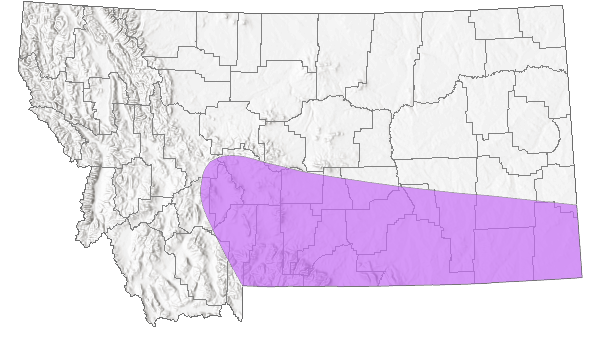View in other NatureServe Network Field Guides
NatureServe
Montana
Utah
Wyoming
Idaho
Wisconsin
British Columbia
South Carolina
Yukon
California
New York
Stevenson's Shieldback Katydid - Pediodectes stevensoni
General Description
The following comes from Caudell (1907), Hebard (1928), and Vickery and Kevan (1985). The head is of moderate size. The pronotum (thorax) is large and moderately elongated and without carinae (ridges), but some individuals may possess traces on the posterior portion where the disk may be somewhat flattened. The lateral lobes are well developed. The front of the sternum (prosternum) possesses a pair of variable spines, which can be short and blunt or long and sharp. The wings of the female are generally hidden under the pronotum. Male wings usually extend beyond the pronotum about one-third, or less, its length. The hind femur is more than two times as long as the pronotum and much enlarged at its base. The front tibia possess three spines, sometimes four.
Note on the genera Pediodectes and Steiroxys
These two genera have never been studied in detail. Some of the other eight known species presently recognized may not be valid and others may still be awaiting discovery. This lack of study remains as current today as it did at the turn of the 20th century. In the early literature, the genus of this species was Stipator (Caudell 1907).
Calling song description
No verbal song descriptions are found in the literature for this species. However, the writer of this description offers the following based upon personal observations, recordings, and the audio from Walker (2020), “A series of faint, raspy chirps about every 2 seconds” (Scott personal field note entry, August 28, 2011).
Phenology
To date, no studies nor observations have been found within the published literature. Possibly similar to other Shieldbacks in their adult stage.
Diagnostic Characteristics
The length of the male pronotum is 5-6.5 mm, and for females, 5-7 mm. The male hind femur length is 16-18 mm, and for females 15-21 mm. The ovipositor is 14-18 mm (Caudell 1907).
The Stevenson’s Shieldback can be confused and misidentified with the
Grass Shieldback (
Steiroxys trilineatus), but unlikely with other Shieldbacked species, such as
Anabrus and
Peranabrus.
Species Range
Montana Range
Range Descriptions

 Native
Native
Range Comments
This species’ occurs from south-central Montana and southern South Dakota, southward to Texas; east of the Rocky Mountain Range, eastward to Nebraska. In Montana, it has been reported in 3 counties (Vickery and Kevan 1985, Scott 2010, and Walker SINA website 2020).
Habitat
No studies have been reported in the literature relative to this species’ preferred habitat. The most recent collection of two specimens (both females) were made in Billings, Yellowstone County, in late August 2011 at two separate locations. One habitat was a grassy area amid a sagebrush-juniper community, the second area amid snowberry,
Symphoricarpos sp. with mixed grasses in an
Eastern cottonwood (
Populus deltoides), riparian woodland (Scott 2010, map only [live specimens collected, photographed, and habitat noted post-publication]).
Food Habits
Stevenson’s Shieldback is thought to be both herbivorous and carnivorous. Otherwise, no specific food habits are presently known (Caudell 1907).
Reproductive Characteristics
To date, no studies nor observations have been found within the published literature.
Stewardship Responsibility
References
- Literature Cited AboveLegend:
 View Online Publication
View Online Publication Caudell, A.N. 1907. The Decticinae (a Group of Orthoptera) of North America. Proceedings of the National Museum 32:285-410.
Caudell, A.N. 1907. The Decticinae (a Group of Orthoptera) of North America. Proceedings of the National Museum 32:285-410. Hebard, M. 1928. The Orthoptera of Montana. Proceedings of the Academy of Natural Sciences of Philadelphia, Vol. 80:211-306.
Hebard, M. 1928. The Orthoptera of Montana. Proceedings of the Academy of Natural Sciences of Philadelphia, Vol. 80:211-306. Scott, R.D. 2010. Montana Grasshoppers, Katydids, and Crickets A Pictorial Field Guide to the Orthoptera. MagpieMTGraphics, Billings, MT.
Scott, R.D. 2010. Montana Grasshoppers, Katydids, and Crickets A Pictorial Field Guide to the Orthoptera. MagpieMTGraphics, Billings, MT. Vickery, V. R. and D. K. M. Kevan. 1985. The grasshopper, crickets, and related insects of Canada and adjacent regions. Biosystematics Research Institute, Ottawa, Ontario. Publication Number 1777. 918 pp.
Vickery, V. R. and D. K. M. Kevan. 1985. The grasshopper, crickets, and related insects of Canada and adjacent regions. Biosystematics Research Institute, Ottawa, Ontario. Publication Number 1777. 918 pp. Walker T.J.(ed.). 2020. Singing insects of North America. Accessed 10 February 2021. https://orthsoc.org/sina/
Walker T.J.(ed.). 2020. Singing insects of North America. Accessed 10 February 2021. https://orthsoc.org/sina/
- Additional ReferencesLegend:
 View Online Publication
View Online Publication
Do you know of a citation we're missing? Capinera, J.L., R.D. Scott, and T.J. Walker. 2004. Field Guide to Grasshoppers, Katydids, and Crickets of the United States. Ithaca, NY. Cornell University Press.
Capinera, J.L., R.D. Scott, and T.J. Walker. 2004. Field Guide to Grasshoppers, Katydids, and Crickets of the United States. Ithaca, NY. Cornell University Press. Fulton, B.B. 1933. Stridulating organs of female Tettigoniidae (Orthoptera). Entomological News XLIV:270-275.
Fulton, B.B. 1933. Stridulating organs of female Tettigoniidae (Orthoptera). Entomological News XLIV:270-275. Gurney, A.B. 1939. Aids to the identification of the Mormon and Coulee Crickets and their allies (Orthoptera; Tettigoniidae, Gryllacrididae). U.S.D.A. Bureau of Entomology and Plant Quarantine Bulletin E. 30 p.
Gurney, A.B. 1939. Aids to the identification of the Mormon and Coulee Crickets and their allies (Orthoptera; Tettigoniidae, Gryllacrididae). U.S.D.A. Bureau of Entomology and Plant Quarantine Bulletin E. 30 p. Gwynne, D.T. 2001. Katydids and Bush-Crickets, Reproductive Behavior and Evolution of the Tettigoniidae. Ithaca, NY: Cornell University Press.
Gwynne, D.T. 2001. Katydids and Bush-Crickets, Reproductive Behavior and Evolution of the Tettigoniidae. Ithaca, NY: Cornell University Press. Helfer, J.R. 1971. How to Know the Grasshoppers, Crickets, Cockroaches, and Their Allies. Revised edition (out of print), Mineola, NY: Dover Publications.
Helfer, J.R. 1971. How to Know the Grasshoppers, Crickets, Cockroaches, and Their Allies. Revised edition (out of print), Mineola, NY: Dover Publications.
- Web Search Engines for Articles on "Stevenson's Shieldback Katydid"
- Additional Sources of Information Related to "Insects"





